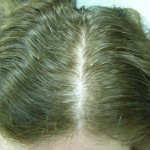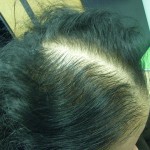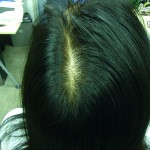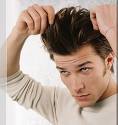Male hair loss can be treated.
14.01.2010 in HAIR LOSS [ PHOTOS ] TREATED, MALE HAIR LOSSDo you have Hair Loss Problems, read our Hair Loss Help
no comment

Do you have Hair Loss Problems, read our Hair Loss Help
no commentThe signs are subtle: a too wide parting in your hair or more strands than normal in your brush. Or they could be obvious: an overall thinning or balding spot.



Female hair loss is fairly common, trichologists and doctors say, and in some cases, it could signal a potentially serious medical problem.
What causes hair loss?
Blame the three H’s: heredity, hormones and health problems. In addition to your genetics, the doctors said hormone imbalances after childbirth, during menopause and at puberty can cause hair loss. So can certain types of lupus, thyroid problems, low iron stores and vitamin deficiencies. Other triggers include too tight braids or ponytails, stress, rapid weight loss or following a vegan diet without taking supplements.
How common is it?
This problem is more common than most people think. “About 50 to 80 percent of women will experience some hair loss in their life, although official numbers probably say it is 20 percent,” Hair loss is very common among older women, but it is the younger women who come in for treatment for vanity reasons.
Is the problem getting worse?
There is no hard data on women’s hair loss, and there is no reason to believe it has been increasing. Permanent hair loss caused by stress to the hair may be decreasing, because hairdressers and beauticians are more aware of the hazards of pulling hair too tight when braiding or using relaxers to straighten your tresses.
Do you have Hair Loss Problems, read our Hair Loss Help
no comment
Question: I’m 25 years of age. Over the past 12 months I have started to lose my hair and feel that I will be bald like my father. I was wondering if I can do anything about hair restoration. What would you advise?
Answer: Male pattern hair loss (balding), also called androgenic alopecia, appears as a receding hairline with or without hair loss on the top of the head. It is an inherited condition. Men who develop balding are genetically more sensitive to the effects of the hormone dihydrotestorone (DHT). It is thought that DHT shortens the amount of time the hair spends in the growth phase. It also causes the hairs to become smaller and finer (miniaturisation).
It was said that baldness was inherited from the mother’s side of the family, but it is now believed that it can come from either side of the family. About 50 per cent of men by the age of 50 will have some degree of male pattern hair loss.
There are a number of treatments available for male pattern hair loss with varying success rates.
Do you have Hair Loss Problems, read our Hair Loss Help
no commentNew research has revealed that one in three women will suffer from alopecia, but far too little is known about the condition.

What’s your party trick? Mine is to pull up my hair and reveal the big, smooth bald patch behind my left ear. It works a treat because nobody expects a 29-year-old woman to be suffering from hair loss. Surely that’s the preserve of men of a certain age?
Well no, actually. Last week a survey revealed that as many as one in three women over the age of 25 suffers from some sort of hair loss, or alopecia as it is known. Trichologists are now seeing more and more females with receding hair lines, thinning locks and even complete baldness. “I have worked in this industry for 40 years,” says Carol Michaelides, a senior trichologist at hair specialists Phillip Kingsley. “And where once you used to see women with hair problems twice a year, now we get them once a week.”
TV presenter Gail Porter was pregnant with daughter Honey in 2005 when she noticed her hair was falling out in clumps. Within four weeks she was completely bald.
Mine started falling out when I was 19, and has been coming and going as it pleases ever since. I remember the moment that I discovered the small bald patch on the back of my head. My sister was straightening my hair when she announced that there was something I should see. It was a tiny patch, curiously smooth and strangely comforting to touch. I thought nothing of it. But within a month it had grown from the size of a five pence piece to that of a ten pound note, and within two months I had lost half of my hair.
This was strange territory. I was a young girl about to start at university. And yet when I looked in the mirror I saw the scalp of a middle-aged man. I had such a small amount of hair that, to my horror, I was forced into sporting a Bobby Charlton comb-over. How had it come to this? What was happening to me?
I went to my GP who told me dismissively that I had something called alopecia areata, where hair falls out in patches. What caused it? Nobody really knows, she said. Was there any treatment for it? No, not really. And then she gave me a look that said ‘why are you bothering me with this when there are ill people in the waiting room?’ (That seems to be quite a common reaction, perhaps because so little is known about why a woman’s hair falls out).
So off I went, none the wiser and certainly with no more hair, though with a new sense of guilt at how vain and pathetic I was to care about something as trivial as hair. I kept thinking about women who had gone bald because of chemotherapy, and I thought that I should count my lucky stars that wasn’t what had happened to me.
I learnt that alopecia areata is an auto-immune condition, like psoriasis and rheumatoid arthritis. The immune system rejects the hair follicle, though why this happens nobody knows. There are thought to be links to physical stress, and emotional stress may perpetuate it, but scientists don’t know what triggers it, or how to stop it.
I remember being prescribed a steroid cream, which got rid of patches, only for them to appear somewhere else – it was like playing cat and mouse with hair loss. For some sufferers, their patches will disappear in months, never to return; unfortunately for others the hair never grows back. I am somewhere between the two. After six months my hair returned – it was strange, fine, baby hair – and I haven’t had alopecia as badly since. I always have a patch but am fortunate in that, weirdly, the rest of my hair is so thick and long that it usually covers it.
Michaelides says that some trichologists also advise a treatment in which the scalp is exposed to UV rays. “You create mild sunburn and we think it tricks the immune system into reawakening the hair follicle.”
Best advice? Try not to panic, that will only make it worse. Remember that more women have experienced alopecia than you realise.
Do you have Hair Loss Problems, read our Hair Loss Help
no comment
Depending on your type of hair loss, treatments are available. If a medicine is causing your hair loss, your doctor may be able to prescribe a different medicine. Recognizing and treating an infection may help stop the hair loss. Correcting a hormone imbalance may prevent further hair loss.
Treatments may also help slow or prevent the development of common baldness. One treatment, minoxidil another is Vitastim, these are available without a prescription. It is applied to the scalp. Both men and women can use it. Another treatment, Biostim, this again is available without a prescription. It comes in a lotion form and is appropriate for both men and women to use. It may take up to 6 months before you can tell if one of these treatments is working.
If adequate treatment is not available for your type of hair loss, you may consider trying different hairstyles or wigs, hairpieces, hair weaves or artificial hair replacement. These are for extreme cases, as most types of hair loss are treatable in the early stages these days.
Do you have Hair Loss Problems, read our Hair Loss Help
no comment


